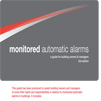Building owners, managers and occupiers have a statutory responsibility to ensure their monitored automatic fire alarm system is functional at all times.
It is now an offence in Victoria to damage or interfere with a fire indicator panel or other apparatus that transmits the signal to the fire services (monitored automatic alarm system) without reasonable excuse.
Monitored Automatic Alarms Guidelines
 The Monitored Automatic Guidelines (PDF 314.6KB) helps building owners, managers and occupiers know their rights and responsibilities in relation to monitored automatic alarms in buildings.
The Monitored Automatic Guidelines (PDF 314.6KB) helps building owners, managers and occupiers know their rights and responsibilities in relation to monitored automatic alarms in buildings.
Preventing unwanted false alarms
Automatic alarms can sometimes generate false alarm calls to the fire services. Building owners, managers and occupiers should be proactive in reducing these unwanted alarms. Read about how to prevent false alarms.
How a typical system works
A building with a direct automatic alarm has detectors that activate under certain conditions.
They are designed to detect fire situations or other hazards, however they will activate under other similar situations. For example, a smoke detector will activate if dust or steam is present causing a false alarm.
Small groups of detectors are wired into the fire indicator panel (FIP) as separate circuits or zones. More complex systems may have other panels or sprinklers wired into the FIP. Each main component is then wired into the alarm signalling equipment (ASE) as a separate input.
The system should be continuously monitored, and the signal automatically transmitted to dispatch the fire brigade. Signals from alarm signalling equipment (ASE) on site are sent through to a monitoring company, which then passes the message on to the dispatch centre for action. The whole process must take less than 20 seconds to be compliant.
At the time of activation, the ASE will send a signal via the monitoring provider to Triple Zero Victoria as the dispatch centre, and fire trucks will be sent to the site according to pre-arranged turnout requirements.
Understanding your fire alarm system is essential for correct management of your building site. All sites with monitored automatic alarms should be managed by people who understand how the system works, and who have the knowledge to isolate individual circuits. Your fire maintenance contractor may be able to help you with additional information about your system.
Maintenance of fire alarm systems
Modern day fire alarm systems are complex, and need to be maintained by a reputable fire maintenance company that has expertise in this field.
As a minimum requirement, an automatic fire alarm system should be designed, installed and maintained in accordance with the requirements of the relevant Australian Standards.
In certain environments additional maintenance is often necessary to prevent unwanted false alarms.
Does your alarm system suit your needs? Check whether any of the following apply to you:
- Have any renovations changed the building layout?
- Are the rooms being used for a different purpose?
- Has your old fire alarm system been upgraded?
- Has a new building been constructed and standard fire protection installed without tailoring the type and calibration of detectors to the use of individual rooms or areas?
See the Monitored Automatic Guidelines (PDF 314.6KB) for more advice on managing your fire alarm system.
Page last updated: Tuesday, 19 December 2023 3:15:09 PM